How to Realize Synergistic Emission Reduction in Future Urban Agglomerations: Spatial Planning Approaches to Reducing Carbon Emissions from Land Use: A Case Study of the Beijing–Tianjin–Hebei Region
Abstract
:1. Introduction
2. Study area and Materials
2.1. Study Area
2.2. Data Sources
3. Methodology
- Land use pattern under the future LCD scenario: We used the PLUS model to import a dataset that includes land use data spanning three periods from 2010 to 2020, as well as climate, environment, and future driving factors to investigate the land use pattern under both the natural development (ND) scenario and ecological protection (EP) scenario in the BTH in 2035. We analyzed the carbon emission characteristics under the different scenarios and used the carbon emission and ecological support coefficient (ESC) as the criteria to screen the development scenarios that are more conducive to LCD scenarios.
- Spatial connection analysis of carbon emissions under the LCD scenario: We introduced the carbon emission and socioeconomic data into the gravity model to formulate the carbon emission gravity matrix for the BTH region. We used SNA to assess the spatial network characteristics of carbon emissions in the BTH in 2035 under the LCD scenario.
- Carbon balance zoning planning under the 2035 LCD scenario in the BTH: Drawing from the land use pattern under the LCD scenario and the spatial network characteristics of future carbon emissions, we analyzed the status and role of each region in increasing sinks and reducing emissions. On this basis, we formulated a future carbon balance zoning plan for the BTH to pinpoint critical areas for implementing the emission peak and carbon neutrality projects.
3.1. Multi-Scenario Land Use Pattern Projections
3.2. Carbon Emissions Accounting
3.2.1. Carbon Emission Calculation Model
3.2.2. Ecological Support Coefficient
3.3. Spatial Correlation Analysis of Carbon Emissions Based on SNA
3.4. Carbon Balance Planning for the BTH Urban Agglomeration in 2035 under the LCD Scenario
3.4.1. Carbon Balance Zoning Planning
3.4.2. Key Carbon Balance and County Planning
4. Results
4.1. Multi-Scenario Carbon Emission Analysis of the BTH Urban Agglomeration in 2035
4.1.1. Simulation Accuracy Verification
4.1.2. Land Use Distribution Pattern
4.1.3. Spatial Distribution of Carbon Emissions
4.1.4. Ecological Support Coefficient
4.2. Spatial Correlation Analysis of Carbon Emissions in the BTH Urban Agglomeration under the LCD Scenario
4.2.1. Carbon Emission Network in the BTH Urban Agglomeration
4.2.2. Analysis of the Centrality of Counties in the Carbon Emission Networks
4.3. Carbon Balance Planning for the BTH Urban Agglomeration in 2035 under the LCD Scenario
4.3.1. Carbon Balance Zoning Planning
4.3.2. Key Carbon Balance and County Planning
5. Discussion
5.1. Multi-Scenario Simulation of Land Use
5.2. Characteristics of Carbon Emission Spatial Networks
5.3. Recommendations for Key Areas for the Implementation of Emission Peak and Carbon Neutrality Projects
5.4. A Low-Carbon-Oriented Urban Agglomeration Planning Framework
- (1)
- By simulating multiple scenarios of land use, we calculated the carbon emissions of urban agglomerations under different scenarios for the future, selected development scenarios align more favorably with low-carbon principles, and optimized the overall spatial scale of regional carbon emissions from the standpoint of urban agglomerations. This approach has been validated in most urban studies [88,89,90], demonstrating that this top-down carbon reduction strategy can be used to adjust future urban land demand, formulate urban expansion plans with minimal ecological losses, and promote compact and green urban development.
- (2)
- Taking into account the carbon emission characteristics and spatial correlation of urban agglomerations, we utilized carbon balance zoning planning to delineate four distinct carbon balance-oriented zones at the internal spatial correlation level of urban agglomerations. This approach clarifies the spatial development pattern of carbon emissions within urban agglomerations and addresses the question of how to perceive spatial carbon effects. Regional planning with different orientations helps divide the “zoning entities” under the concept of functional control of the main body. The “zoning” control emphasizes respecting and balancing the different roles played by different zoning entities in regulating regional carbon balance, to better protect ecological space and coordinate urban spatial development [43,91].
- (3)
- Through the analysis of individual network characteristics in social network analysis, we developed the key carbon balance and county planning based on the centrality indicators of each county and analyzed their position within the carbon emission network. Clear guidance and development goals for carbon reduction actions in different counties were established. In the field of urban planning, the literature has shown that governments and policymakers worldwide intend to utilize various data and measurement methods to ascertain urban characteristics; summarize regional political, economic, and social characteristics; and plan cities based on these factors to better address the needs of people regarding housing, economic opportunities, and social system changes [87].
- (4)
- Finally, we developed key areas for the implementation of emission peak and carbon neutrality projects by analyzing the land features within the county. By scaling down from the level of urban agglomerations, we analyzed the composition of land parcel elements within the county. By optimizing the structure of industrial land, energy land, ecological land, agricultural land, and transportation land, we further optimized the structure of the carbon-source and carbon-sink land and implemented urban spatial planning accordingly. We guided the practice of county-level urban spatial planning in terms of low-carbon layout, low-carbon industries, low-carbon transportation, low-carbon human settlements, and ecological green spaces to better regulate carbon spatial layout and formulate a carbon intensity design. Urban and transportation planners have conducted various studies on achieving carbon neutrality goals at this level, and combined with the low-carbon planning tasks of county-level urban spaces, they have screened and extracted planning and control elements from both qualitative and quantitative perspectives, and implemented them in practice [45,92,93,94].
5.5. Limitations
6. Conclusions and Contribution
- We simulated land use patterns under the ND and EP scenarios in the BTH in 2035. Carbon emissions from land use under the EP scenario decreased by 643.42 × 104 t. The spatial distribution was characterized by lower carbon emission and higher ESC values in the northwest and higher carbon emissions and lower ESC values in the central, southern, and eastern regions. We selected the EP scenario as the prediction result of the LCD scenario for the BTH in 2035 for further analysis;
- Carbon emissions within the BTH were closely related, forming three major carbon emission linkage areas: Beijing–Tianjin–Tangshan–Baoding–Cangzhou, Shijiazhuang, and Xingtai–Handan. The counties of Beijing, Tianjin, Baoding, Hengshui, and Cangzhou and other cities in the central region had different levels of individual centrality.
- Based on the characteristics of the ESC and carbon emission network, we formulated a carbon balance zoning plan for the BTH urban agglomeration in 2035 under the LCD scenario. The urban agglomeration underwent division into four areas: ecological conservation, carbon sink balance, carbon emission control, and low-carbon control areas. Furthermore, we selected the core counties, promotion counties, bridge counties, and improvement counties according to the characteristics of the network centrality. We pinpointed critical zones for the execution of emission peak and carbon neutrality projects within the distinctive counties. Furthermore, we put forth tailored recommendations aimed at mitigating carbon emissions and augmenting carbon sinks based on the prevailing characteristics of the study area.
Author Contributions
Funding
Data Availability Statement
Conflicts of Interest
References
- Masson-Delmotte, V.; Zhai, P.; Pirani, A.; Connors, S.L.; Péan, C.; Berger, S.; Caud, N.; Chen, Y.; Goldfarb, L.; Gomis, M. Climate change 2021: The physical science basis. In Contribution of Working Group I to the Sixth Assessment Report of the Intergovernmental Panel on Climate Change; 2021; Volume 2, p. 2391. Available online: https://www.ipcc.ch/report/ar6/wg1/ (accessed on 15 April 2024).
- Pachauri, R.K.; Gomez-Echeverri, L.; Riahi, K. Synthesis Report: Summary for Policy Makers, 2014; pp. 1–30.
- Meng, L.; Graus, W.; Worrell, E.; Huang, B. Estimating CO2 (carbon dioxide) emissions at urban scales by DMSP/OLS (Defense Meteorological Satellite Program’s Operational Linescan System) nighttime light imagery: Methodological challenges and a case study for China. Energy 2014, 71, 468–478. [Google Scholar] [CrossRef]
- Li, L.; Ma, S.; Zheng, Y.; Xiao, X. Integrated regional development: Comparison of urban agglomeration policies in China. Land Use Policy 2022, 114, 105939. [Google Scholar] [CrossRef]
- Lin, Q.; Zhang, L.; Qiu, B.; Zhao, Y.; Wei, C. Spatiotemporal analysis of land-use patterns on carbon emissions in China. Land 2021, 10, 141. [Google Scholar] [CrossRef]
- Li, W.; Ciais, P.; Peng, S.; Yue, C.; Wang, Y.; Thurner, M.; Saatchi, S.S.; Arneth, A.; Avitabile, V.; Carvalhais, N. Land-use and land-cover change carbon emissions between 1901 and 2012 constrained by biomass observations. Biogeosciences 2017, 14, 5053–5067. [Google Scholar] [CrossRef]
- Zhao, J.; Cohen, J.B.; Chen, Y.; Cui, W.; Cao, Q.; Yang, T.; Li, G. High-resolution spatiotemporal patterns of China’s FFCO2 emissions under the impact of LUCC from 2000 to 2015. Environ. Res. Lett. 2020, 15, 044007. [Google Scholar] [CrossRef]
- Jing, Q.; Bai, H.; Luo, W.; Cai, B.; Xu, H. A top-bottom method for city-scale energy-related CO2 emissions estimation: A case study of 41 Chinese cities. J. Clean. Prod. 2018, 202, 444–455. [Google Scholar] [CrossRef]
- Yang, S.; Fu, W.; Hu, S.; Ran, P. Watershed carbon compensation based on land use change: Evidence from the Yangtze River Economic Belt. Habitat Int. 2022, 126, 102613. [Google Scholar] [CrossRef]
- Basse, R.M.; Omrani, H.; Charif, O.; Gerber, P.; Bódis, K. Land use changes modelling using advanced methods: Cellular automata and artificial neural networks. The spatial and explicit representation of land cover dynamics at the cross-border region scale. Appl. Geogr. 2014, 53, 160–171. [Google Scholar] [CrossRef]
- Ku, C.-A. Incorporating spatial regression model into cellular automata for simulating land use change. Appl. Geogr. 2016, 69, 1–9. [Google Scholar] [CrossRef]
- Verburg, P.H.; Soepboer, W.; Veldkamp, A.; Limpiada, R.; Espaldon, V.; Mastura, S.S. Modeling the spatial dynamics of regional land use: The CLUE-S model. Environ. Manag. 2002, 30, 391–405. [Google Scholar] [CrossRef]
- Liu, X.; Liang, X.; Li, X.; Xu, X.; Ou, J.; Chen, Y.; Li, S.; Wang, S.; Pei, F. A future land use simulation model (FLUS) for simulating multiple land use scenarios by coupling human and natural effects. Landsc. Urban Plan. 2017, 168, 94–116. [Google Scholar] [CrossRef]
- Xie, L.; Bai, Z.; Yang, B.; Fu, S. Simulation Analysis of Land-Use Pattern Evolution and Valuation of Terrestrial Ecosystem Carbon Storage of Changzhi City, China. Land 2022, 11, 1270. [Google Scholar] [CrossRef]
- Dong, L.; Liang, H.; Zhang, L.; Liu, Z.; Gao, Z.; Hu, M. Highlighting regional eco-industrial development: Life cycle benefits of an urban industrial symbiosis and implications in China. Ecol. Model. 2017, 361, 164–176. [Google Scholar] [CrossRef]
- Qian, Y.; Wang, H.; Wu, J. Spatiotemporal association of carbon dioxide emissions in China’s urban agglomerations. J. Environ. Manag. 2022, 323, 116109. [Google Scholar] [CrossRef] [PubMed]
- Shen, W.; Liang, H.; Dong, L.; Ren, J.; Wang, G. Synergistic CO2 reduction effects in Chinese urban agglomerations: Perspectives from social network analysis. Sci. Total Environ. 2021, 798, 149352. [Google Scholar] [CrossRef]
- Dong, J.; Li, C. Structure characteristics and influencing factors of China’s carbon emission spatial correlation network: A study based on the dimension of urban agglomerations. Sci. Total Environ. 2022, 853, 158613. [Google Scholar] [CrossRef]
- Yu, Z.; Chen, L.; Tong, H.; Chen, L.; Zhang, T.; Li, L.; Yuan, L.; Xiao, J.; Wu, R.; Bai, L. Spatial correlations of land-use carbon emissions in the Yangtze River Delta region: A perspective from social network analysis. Ecol. Indic. 2022, 142, 109147. [Google Scholar] [CrossRef]
- Wang, C.; Zhan, J.; Zhang, F.; Liu, W.; Twumasi-Ankrah, M.J. Analysis of urban carbon balance based on land use dynamics in the Beijing-Tianjin-Hebei region, China. J. Clean. Prod. 2021, 281, 125138. [Google Scholar] [CrossRef]
- Hurlimann, A.; Moosavi, S.; Browne, G.R. Urban planning policy must do more to integrate climate change adaptation and mitigation actions. Land Use Policy 2021, 101, 105188. [Google Scholar] [CrossRef]
- Haas, J.; Ban, Y. Urban growth and environmental impacts in jing-jin-ji, the yangtze, river delta and the pearl river delta. Int. J. Appl. Earth Obs. Geoinf. 2014, 30, 42–55. [Google Scholar] [CrossRef]
- Gu, R.; Li, C.; Li, D.; Yang, Y.; Gu, S. The impact of rationalization and upgrading of industrial structure on carbon emissions in the Beijing-Tianjin-Hebei urban agglomeration. Int. J. Environ. Res. Public Health 2022, 19, 7997. [Google Scholar] [CrossRef] [PubMed]
- Yang, J.; Huang, X. The 30 m annual land cover dataset and its dynamics in China from 1990 to 2019. Earth Syst. Sci. Data 2021, 13, 3907–3925. [Google Scholar] [CrossRef]
- Zhong, X.; Yan, Q.; Li, G. Development of the Long Time Series Nighttime Light Dataset of China (2000–2020). J. Glob. Chang. Data Discov. 2022, 3, 420–428. [Google Scholar]
- Li, X.; Liu, Z.; Li, S.; Li, Y. Multi-scenario simulation analysis of land use impacts on habitat quality in Tianjin based on the PLUS model coupled with the InVEST model. Sustainability 2022, 14, 6923. [Google Scholar] [CrossRef]
- Luo, S.; Hu, X.; Sun, Y.; Yan, C.; Zhang, X. Multi-scenario land use change and its impact on carbon storage based on coupled Plus-Invest model. Chin. J. Eco-Agric. 2023, 31, 300–314. [Google Scholar]
- Cui, X.; Wei, X.; Liu, W.; Zhang, F.; Li, Z. Spatial and temporal analysis of carbon sources and sinks through land use/cover changes in the Beijing-Tianjin-Hebei urban agglomeration region. Phys. Chem. Earth Parts A/B/C 2019, 110, 61–70. [Google Scholar] [CrossRef]
- Fang, J.; Guo, Z.; Piao, S.; Chen, A. Terrestrial vegetation carbon sinks in China, 1981–2000. Sci. China Ser. D Earth Sci. 2007, 50, 1341–1350. [Google Scholar] [CrossRef]
- Liu, C.; Xu, R.; Xu, K.; Lin, Y.; Cao, Y. Carbon Emission Effects of Land Use in Chaobai River Region of Beijing–Tianjin–Hebei, China. Land 2023, 12, 1168. [Google Scholar] [CrossRef]
- She, W.; Wu, Y.; Huang, H.; Chen, Z.; Cui, G.; Zheng, H.; Guan, C.; Chen, F. Integrative analysis of carbon structure and carbon sink function for major crop production in China’s typical agriculture regions. J. Clean. Prod. 2017, 162, 702–708. [Google Scholar] [CrossRef]
- Tang, X.; Zhao, X.; Bai, Y.; Tang, Z.; Wang, W.; Zhao, Y.; Wan, H.; Xie, Z.; Shi, X.; Wu, B. Carbon pools in China’s terrestrial ecosystems: New estimates based on an intensive field survey. Proc. Natl. Acad. Sci. USA 2018, 115, 4021–4026. [Google Scholar] [CrossRef]
- Yan, H.; Guo, X.; Zhao, S.; Yang, H. Variation of net carbon emissions from land use change in the Beijing-Tianjin-Hebei region during 1990–2020. Land 2022, 11, 997. [Google Scholar] [CrossRef]
- Huang, H.; Zhou, J. Study on the spatial and temporal differentiation pattern of carbon emission and carbon compensation in China’s provincial areas. Sustainability 2022, 14, 7627. [Google Scholar] [CrossRef]
- Rong, T.; Zhang, P.; Jing, W.; Zhang, Y.; Li, Y.; Yang, D.; Yang, J.; Chang, H.; Ge, L. Carbon dioxide emissions and their driving forces of land use change based on Economic Contributive Coefficient (ECC) and Ecological Support Coefficient (ESC) in the lower Yellow river region (1995–2018). Energies 2020, 13, 2600. [Google Scholar] [CrossRef]
- Wang, F.; Gao, M.; Liu, J.; Fan, W. The spatial network structure of China’s regional carbon emissions and its network effect. Energies 2018, 11, 2706. [Google Scholar] [CrossRef]
- Ho, H.-X.T. Forecasting of CO2 emissions, renewable energy consumption and economic growth in vietnam using grey models. In Proceedings of the 2018 4th International Conference on Green Technology and Sustainable Development (GTSD), Ho Chi Minh City, Vietnam, 23–24 November 2018; pp. 452–455. [Google Scholar]
- Wang, B.; Ge, Y. Predicting the influence of Guangfo Metro on the economic level of Foshan City Based on the GM (1, 1) model. IOP Conf. Ser. Earth Environ. Sci. 2021, 634, 012013. [Google Scholar] [CrossRef]
- Zhao, N.; Liu, Y.; Cao, G.; Samson, E.L.; Zhang, J. Forecasting China’s GDP at the pixel level using nighttime lights time series and population images. GIScience Remote Sens. 2017, 54, 407–425. [Google Scholar] [CrossRef]
- Wang, Z.; Li, X.; Mao, Y.; Li, L.; Wang, X.; Lin, Q. Dynamic simulation of land use change and assessment of carbon storage based on climate change scenarios at the city level: A case study of Bortala, China. Ecol. Indic. 2022, 134, 108499. [Google Scholar] [CrossRef]
- Zhang, Z.; Zhang, D. Spatial connection of CO2 emission and carbon balance zoning in Beijing Tianjin Hebei counties based on social network analysis. China Environ. Sci. 2023, 43, 2057–2068. [Google Scholar] [CrossRef]
- Fu, H.; Zhao, S.; Liao, C. Spatial governance of Beijing-Tianjin-Hebei urban agglomeration towards low-carbon transition. China Agric. Econ. Rev. 2022, 14, 774–798. [Google Scholar] [CrossRef]
- Liu, G.; Zhang, F. Land Zoning Management to Achieve Carbon Neutrality: A Case Study of the Beijing–Tianjin–Hebei Urban Agglomeration, China. Land 2022, 11, 551. [Google Scholar] [CrossRef]
- Ewing, R.; Cervero, R. “Does compact development make people drive less?” The answer is yes. J. Am. Plan. Assoc. 2017, 83, 19–25. [Google Scholar] [CrossRef]
- Gao, S.; Zhang, H. Urban planning for low-carbon sustainable development. Sustain. Comput. Inform. Syst. 2020, 28, 100398. [Google Scholar] [CrossRef]
- Malambo, P.; Kengne, A.P.; De Villiers, A.; Lambert, E.V.; Puoane, T. Built environment, selected risk factors and major cardiovascular disease outcomes: A systematic review. PLoS ONE 2016, 11, e0166846. [Google Scholar] [CrossRef] [PubMed]
- Bastin, J.-F.; Finegold, Y.; Garcia, C.; Mollicone, D.; Rezende, M.; Routh, D.; Zohner, C.M.; Crowther, T.W. The global tree restoration potential. Science 2019, 365, 76–79. [Google Scholar] [CrossRef] [PubMed]
- Yang, J. Strategies for low-carbon green growth and urban management in Korea. J. Urban Manag. 2013, 2, 85–101. [Google Scholar] [CrossRef]
- Ye, Y.; Wang, C.; Zhang, Y.; Wu, K.; Wu, Q.; Su, Y. Low-carbon transportation oriented urban spatial structure: Theory, model and case study. Sustainability 2017, 10, 19. [Google Scholar] [CrossRef]
- Cifuentes, L.; Borja-Aburto, V.H.; Gouveia, N.; Thurston, G.; Davis, D.L. Assessing the health benefits of urban air pollution reductions associated with climate change mitigation (2000–2020): Santiago, São Paulo, México City, and New York City. Environ. Health Perspect. 2001, 109, 419–425. [Google Scholar]
- Dudek, D.; Golub, A.; Strukova, E. Ancillary benefits of reducing greenhouse gas emissions in transitional economies. World Dev. 2003, 31, 1759–1769. [Google Scholar] [CrossRef]
- Wang, X.; Smith, K.R. Secondary Benefits of Greenhouse Gas Control: Health Impacts in China. Environ. Sci. Technol. 1999, 33, 3056–3061. [Google Scholar] [CrossRef]
- Djurhuus, S.; Hansen, H.S.; Aadahl, M.; Glümer, C. The association between access to public transportation and self-reported active commuting. Int. J. Environ. Res. Public Health 2014, 11, 12632–12651. [Google Scholar] [CrossRef]
- Florindo, A.A.; Barrozo, L.V.; Turrell, G.; Barbosa, J.P.d.A.S.; Cabral-Miranda, W.; Cesar, C.L.G.; Goldbaum, M. Cycling for transportation in Sao Paulo City: Associations with bike paths, train and subway stations. Int. J. Environ. Res. Public Health 2018, 15, 562. [Google Scholar] [CrossRef] [PubMed]
- Pucher, J.; Dill, J.; Handy, S. Infrastructure, programs, and policies to increase bicycling: An international review. Prev. Med. 2010, 50, S106–S125. [Google Scholar] [CrossRef] [PubMed]
- Bustamante, M.M.; Silva, J.S.; Scariot, A.; Sampaio, A.B.; Mascia, D.L.; Garcia, E.; Sano, E.; Fernandes, G.W.; Durigan, G.; Roitman, I. Ecological restoration as a strategy for mitigating and adapting to climate change: Lessons and challenges from Brazil. Mitig. Adapt. Strateg. Glob. Chang. 2019, 24, 1249–1270. [Google Scholar] [CrossRef]
- Galatowitsch, S.M. Carbon offsets as ecological restorations. Restor. Ecol. 2009, 17, 563–570. [Google Scholar] [CrossRef]
- Lim, C.H.; Lim, B.S.; Kim, A.R.; Kim, D.U.; Seol, J.W.; Pi, J.H.; Lee, H.; Lee, C.S. Climate change adaptation through ecological restoration. In Natural Resources Conservation and Advances for Sustainability; Elsevier: Amsterdam, The Netherlands, 2022; pp. 151–172. [Google Scholar]
- Chen, Y. Does a regional greenhouse gas policy make sense? A case study of carbon leakage and emissions spillover. Energy Econ. 2009, 31, 667–675. [Google Scholar] [CrossRef]
- Gu, G.; Wang, Z.; Wu, L. Carbon emission reductions under global low-carbon technology transfer and its policy mix with R&D improvement. Energy 2021, 216, 119300. [Google Scholar]
- Zhang, Y. Spillover and Feedback Effects in Low Carbon Development; Springer: Singapore; Prime Minister’s Office: Singapore, 2021.
- Cao, S.; Li, C. The exploration of concepts and methods for low-carbon eco-city planning. Procedia Environ. Sci. 2011, 5, 199–207. [Google Scholar] [CrossRef]
- Li, D.; Fan, K.; Lu, J.; Wu, S.; Xie, X. Research on Spatio-Temporal Pattern Evolution and the Coupling Coordination Relationship of Land-Use Benefit from a Low-Carbon Perspective: A Case Study of Fujian Province. Land 2022, 11, 1498. [Google Scholar] [CrossRef]
- Wang, C.; Zhan, J.; Xin, Z. Comparative analysis of urban ecological management models incorporating low-carbon transformation. Technol. Forecast. Soc. Chang. 2020, 159, 120190. [Google Scholar] [CrossRef]
- Wang, Z. Coordinated development of regional resources, environment, and economic growth under the background of low-carbon economy. Front. Ecol. Evol. 2023, 11, 1181990. [Google Scholar] [CrossRef]
- He, K.; Lei, Y.; Pan, X.; Zhang, Y.; Zhang, Q.; Chen, D. Co-benefits from energy policies in China. Energy 2010, 35, 4265–4272. [Google Scholar] [CrossRef]
- Markandya, A.; Armstrong, B.G.; Hales, S.; Chiabai, A.; Criqui, P.; Mima, S.; Tonne, C.; Wilkinson, P. Public health benefits of strategies to reduce greenhouse-gas emissions: Low-carbon electricity generation. Lancet 2009, 374, 2006–2015. [Google Scholar] [CrossRef]
- Friel, S.; Dangour, A.D.; Garnett, T.; Lock, K.; Chalabi, Z.; Roberts, I.; Butler, A.; Butler, C.D.; Waage, J.; McMichael, A.J. Public health benefits of strategies to reduce greenhouse-gas emissions: Food and agriculture. Lancet 2009, 374, 2016–2025. [Google Scholar] [CrossRef]
- Biesbroek, S.; Bueno-de-Mesquita, H.B.; Peeters, P.H.; Verschuren, W.M.; Van Der Schouw, Y.T.; Kramer, G.F.; Tyszler, M.; Temme, E.H. Reducing our environmental footprint and improving our health: Greenhouse gas emission and land use of usual diet and mortality in EPIC-NL: A prospective cohort study. Environ. Health 2014, 13, 1–9. [Google Scholar] [CrossRef] [PubMed]
- Milner, J.; Green, R.; Dangour, A.D.; Haines, A.; Chalabi, Z.; Spadaro, J.; Markandya, A.; Wilkinson, P. Health effects of adopting low greenhouse gas emission diets in the UK. BMJ Open 2015, 5, e007364. [Google Scholar] [CrossRef]
- Springmann, M.; Godfray, H.C.J.; Rayner, M.; Scarborough, P. Analysis and valuation of the health and climate change cobenefits of dietary change. Proc. Natl. Acad. Sci. USA 2016, 113, 4146–4151. [Google Scholar] [CrossRef]
- Xiong, C.; Wang, G.; Su, W.; Gao, Q. Selecting low-carbon technologies and measures for high agricultural carbon productivity in Taihu Lake Basin, China. Environ. Sci. Pollut. Res. 2021, 28, 49913–49920. [Google Scholar] [CrossRef]
- Rogge, K.S.; Pfluger, B.; Geels, F.W. Transformative policy mixes in socio-technical scenarios: The case of the low-carbon transition of the German electricity system (2010–2050). Technol. Forecast. Soc. Chang. 2020, 151, 119259. [Google Scholar] [CrossRef]
- Wang, Y.; Ren, H.; Dong, L.; Park, H.-S.; Zhang, Y.; Xu, Y. Smart solutions shape for sustainable low-carbon future: A review on smart cities and industrial parks in China. Technol. Forecast. Soc. Chang. 2019, 144, 103–117. [Google Scholar] [CrossRef]
- Cheng, Q.; Su, B.; Tan, J. Developing an evaluation index system for low-carbon tourist attractions in China–A case study examining the Xixi wetland. Tour. Manag. 2013, 36, 314–320. [Google Scholar] [CrossRef]
- Cheshmehzangi, A.; Xie, L.; Tan-Mullins, M. The role of international actors in low-carbon transitions of Shenzhen’s International Low Carbon City in China. Cities 2018, 74, 64–74. [Google Scholar] [CrossRef]
- Li, J.H.; Sia, R.; Yang, L. Study on low-carbon development in the eco-tourism area: Taking Qinghai Lake of China as an example. Adv. Mater. Res. 2012, 524, 2442–2447. [Google Scholar] [CrossRef]
- Qing, L. Study on Poyang Lake Tourism Plan under the Low-Carbon Ecology. Appl. Mech. Mater. 2013, 368, 369–374. [Google Scholar] [CrossRef]
- Heinen, D. Growth management for low-carbon development patterns–leverages in state planning enabling legislation. Urban Res. Pract. 2022, 15, 71–93. [Google Scholar] [CrossRef]
- Song, Q.; Liu, T.; Qi, Y. Policy innovation in low carbon pilot cities: Lessons learned from China. Urban Clim. 2021, 39, 100936. [Google Scholar] [CrossRef]
- Chen, J.; Wang, Z. Low-Carbon Rural Landscape Optimization Strategy Based on Green Infrastructure Evaluation. J. Simul. 2021, 9, 125. [Google Scholar]
- Khanna, N.; Fridley, D.; Hong, L. China’s pilot low-carbon city initiative: A comparative assessment of national goals and local plans. Sustain. Cities Soc. 2014, 12, 110–121. [Google Scholar] [CrossRef]
- Gao, J.; Kovats, S.; Vardoulakis, S.; Wilkinson, P.; Woodward, A.; Li, J.; Gu, S.; Liu, X.; Wu, H.; Wang, J. Public health co-benefits of greenhouse gas emissions reduction: A systematic review. Sci. Total Environ. 2018, 627, 388–402. [Google Scholar] [CrossRef]
- Mueller, N.; Daher, C.; Rojas-Rueda, D.; Delgado, L.; Vicioso, H.; Gascon, M.; Marquet, O.; Vert, C.; Martin, I.; Nieuwenhuijsen, M. Integrating health indicators into urban and transport planning: A narrative literature review and participatory process. Int. J. Hyg. Environ. Health 2021, 235, 113772. [Google Scholar] [CrossRef]
- Nieuwenhuijsen, M.J. Urban and transport planning pathways to carbon neutral, liveable and healthy cities; A review of the current evidence. Environ. Int. 2020, 140, 105661. [Google Scholar] [CrossRef]
- Biesbroek, G.R.; Swart, R.J.; Van der Knaap, W.G. The mitigation–adaptation dichotomy and the role of spatial planning. Habitat Int. 2009, 33, 230–237. [Google Scholar] [CrossRef]
- Wang, S.-H.; Huang, S.-L.; Huang, P.-J. Can spatial planning really mitigate carbon dioxide emissions in urban areas? A case study in Taipei, Taiwan. Landsc. Urban Plan. 2018, 169, 22–36. [Google Scholar] [CrossRef]
- Ning, X.; He, Y.; Zhang, J.; Wu, C.; Zhang, Y. Analysis of Carbon Emission Projections and Reduction Potential of Resource-Dependent Urban Agglomerations from the Perspective of Multiple Scenarios—A Case Study of Hu-Bao-O-Yu Urban Agglomeration. Int. J. Environ. Res. Public Health 2023, 20, 4250. [Google Scholar] [CrossRef] [PubMed]
- Wu, W.; Xu, L.; Zheng, H.; Zhang, X. How much carbon storage will the ecological space leave in a rapid urbanization area? Scenario analysis from Beijing-Tianjin-Hebei Urban Agglomeration. Resour. Conserv. Recycl. 2023, 189, 106774. [Google Scholar] [CrossRef]
- Zhang, Y.; Liu, Y.; Wang, Y.; Liu, D.; Xia, C.; Wang, Z.; Wang, H.; Liu, Y. Urban expansion simulation towards low-carbon development: A case study of Wuhan, China. Sustain. Cities Soc. 2020, 63, 102455. [Google Scholar] [CrossRef]
- NCCS Singapore’s Climate Action Plan. Take Action Today, for a Carbon-Efficient Singapore; National Climate Change Secretariat Prime Minister’s Office: Singapore, 2016.
- Damsø, T.; Kjær, T.; Christensen, T.B. Implementation of local climate action plans: Copenhagen–Towards a carbon-neutral capital. J. Clean. Prod. 2017, 167, 406–415. [Google Scholar] [CrossRef]
- Pacheco-Torres, R.; Roldán, J.; Gago, E.; Ordóñez, J. Assessing the relationship between urban planning options and carbon emissions at the use stage of new urbanized areas: A case study in a warm climate location. Energy Build. 2017, 136, 73–85. [Google Scholar] [CrossRef]
- Toh, C.K. Tokyo’s city sustainability: Strategy and plans for net zero emissions by 2050. IET Smart Cities 2022, 4, 81–91. [Google Scholar] [CrossRef]
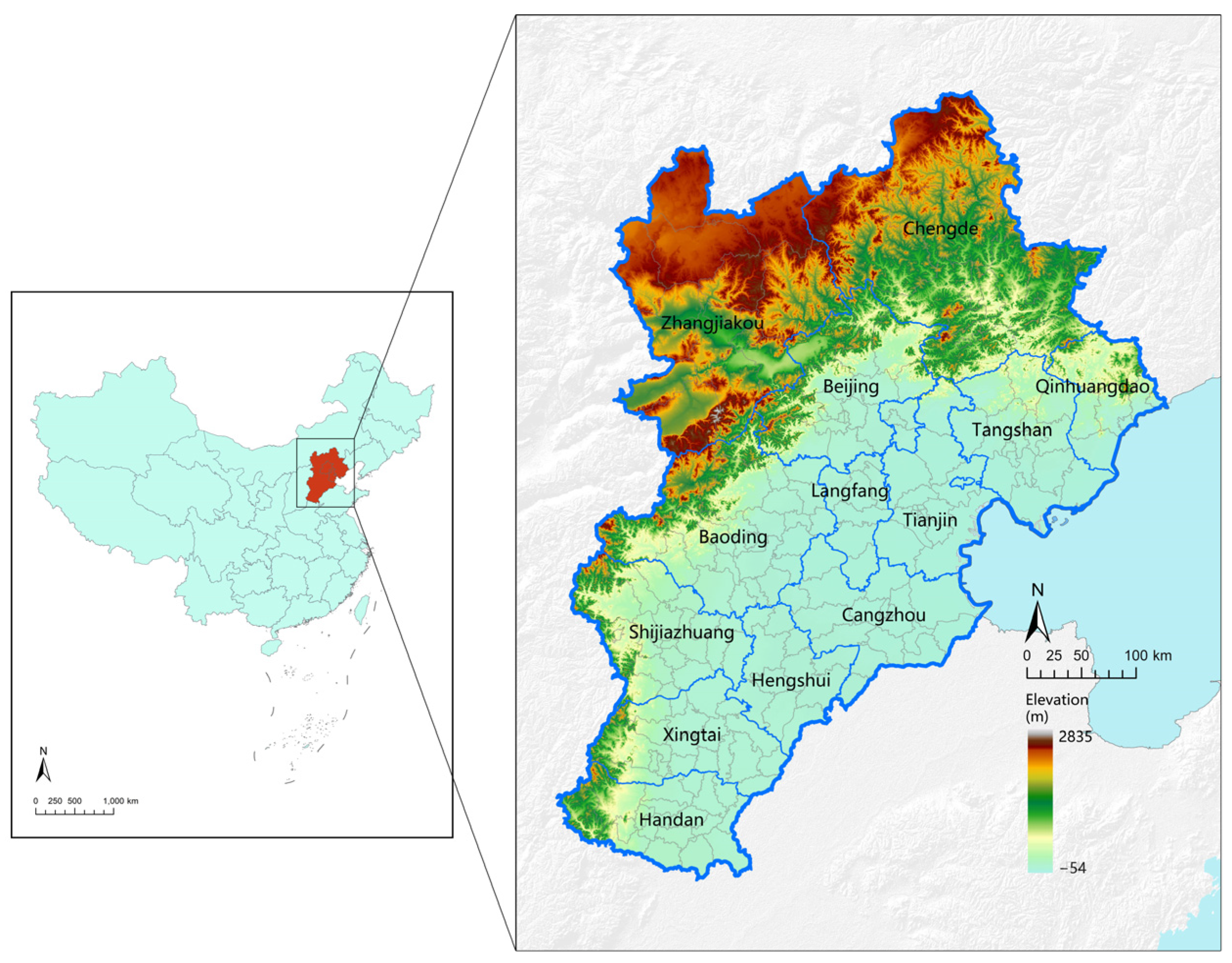

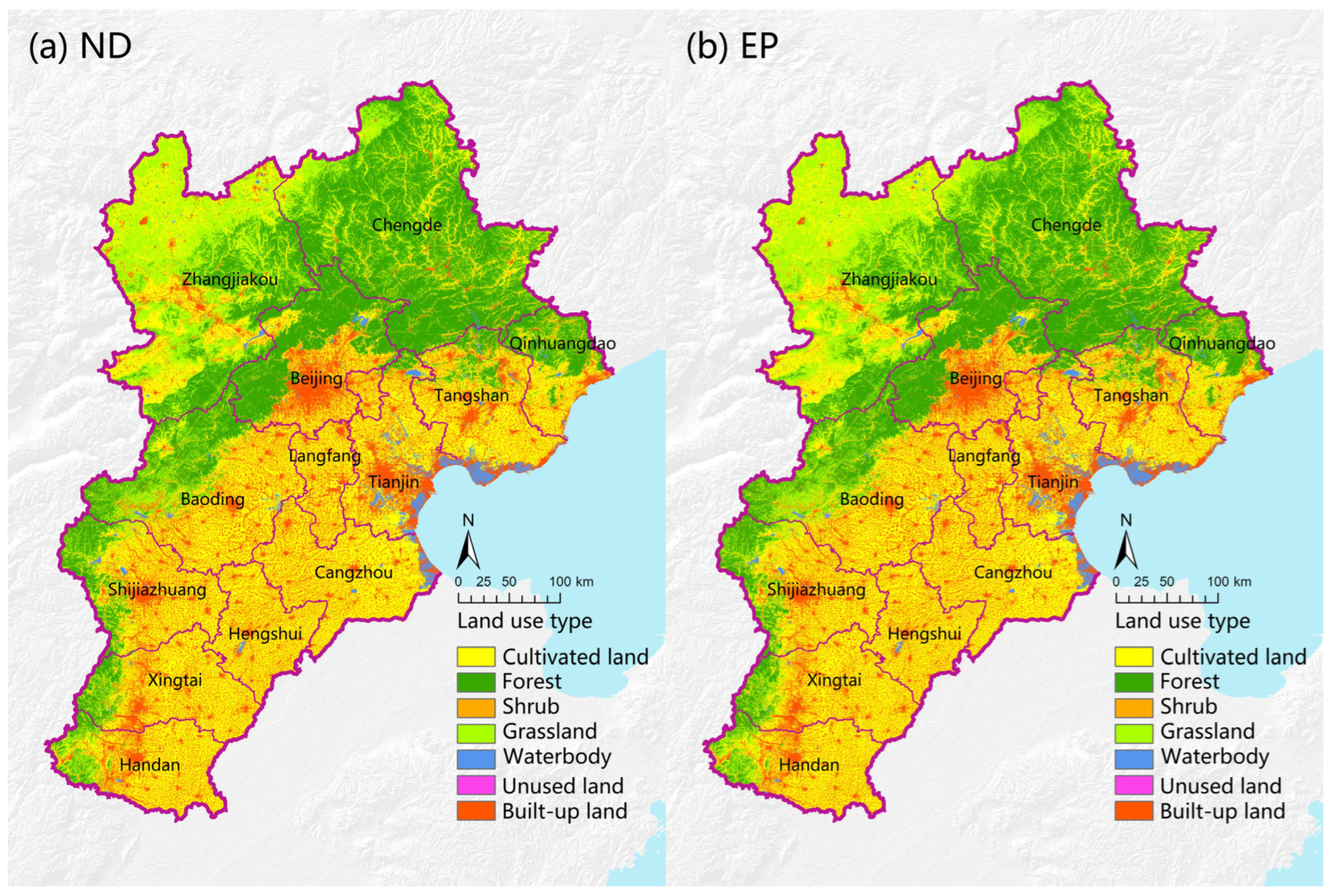


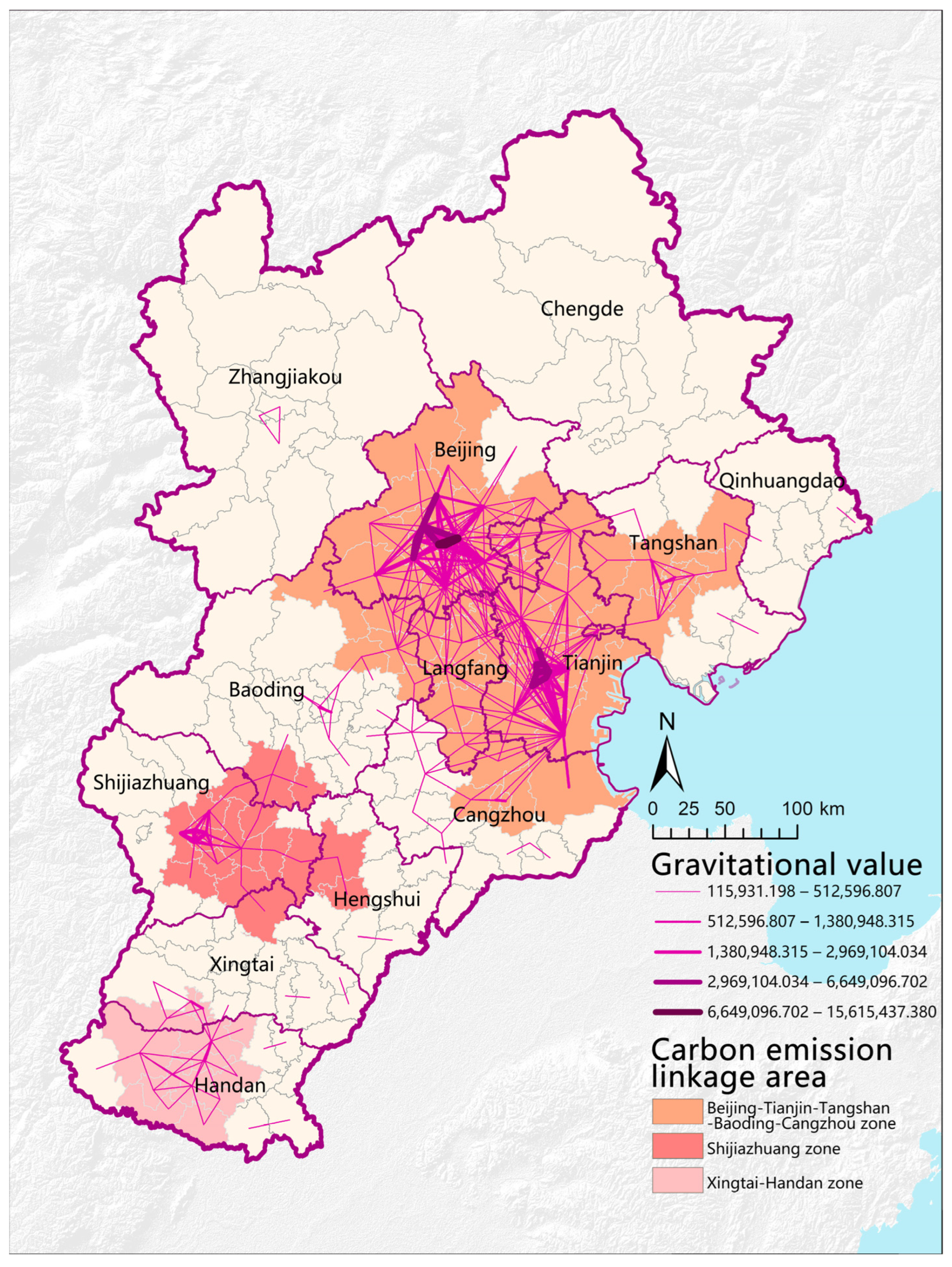
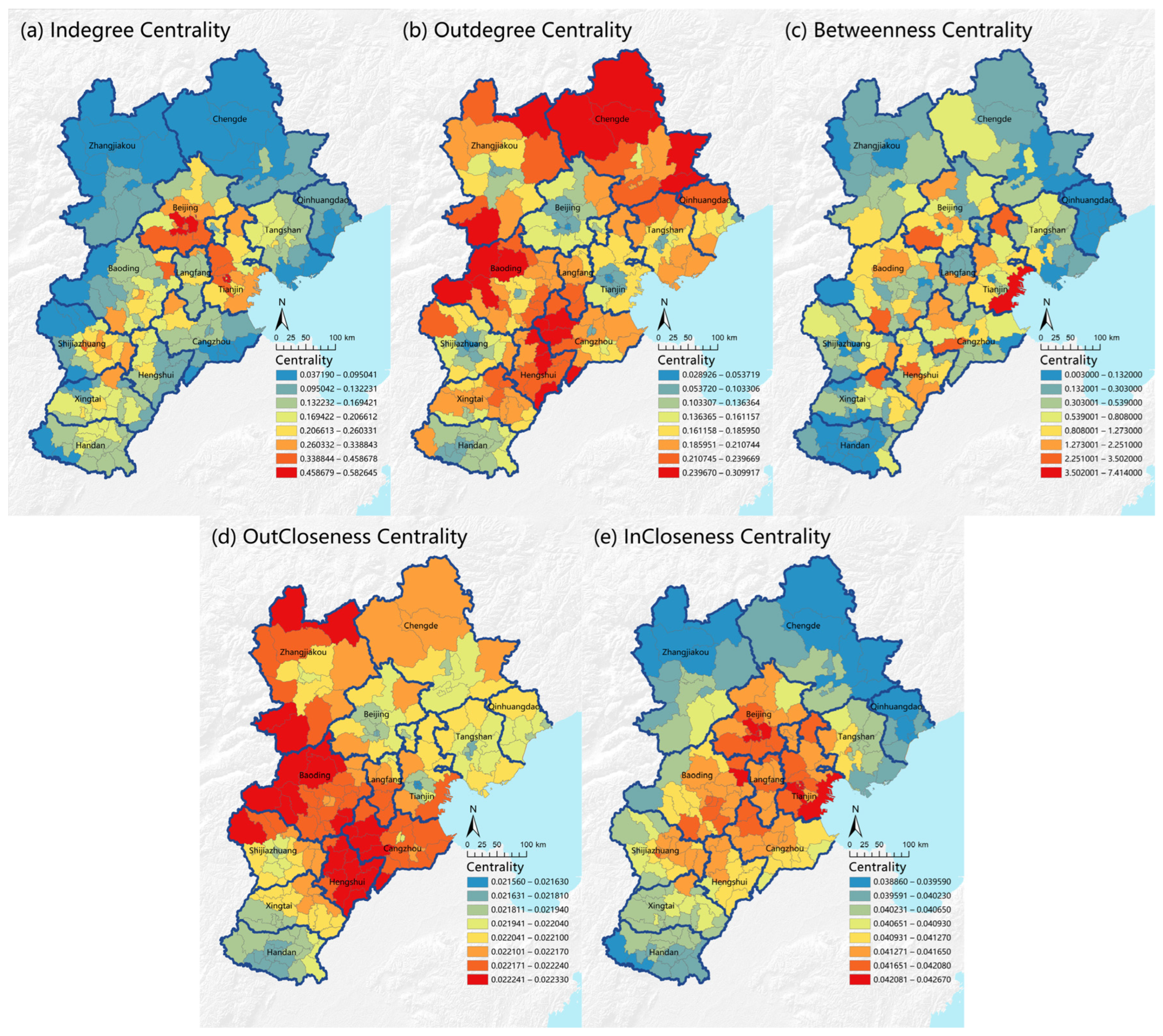
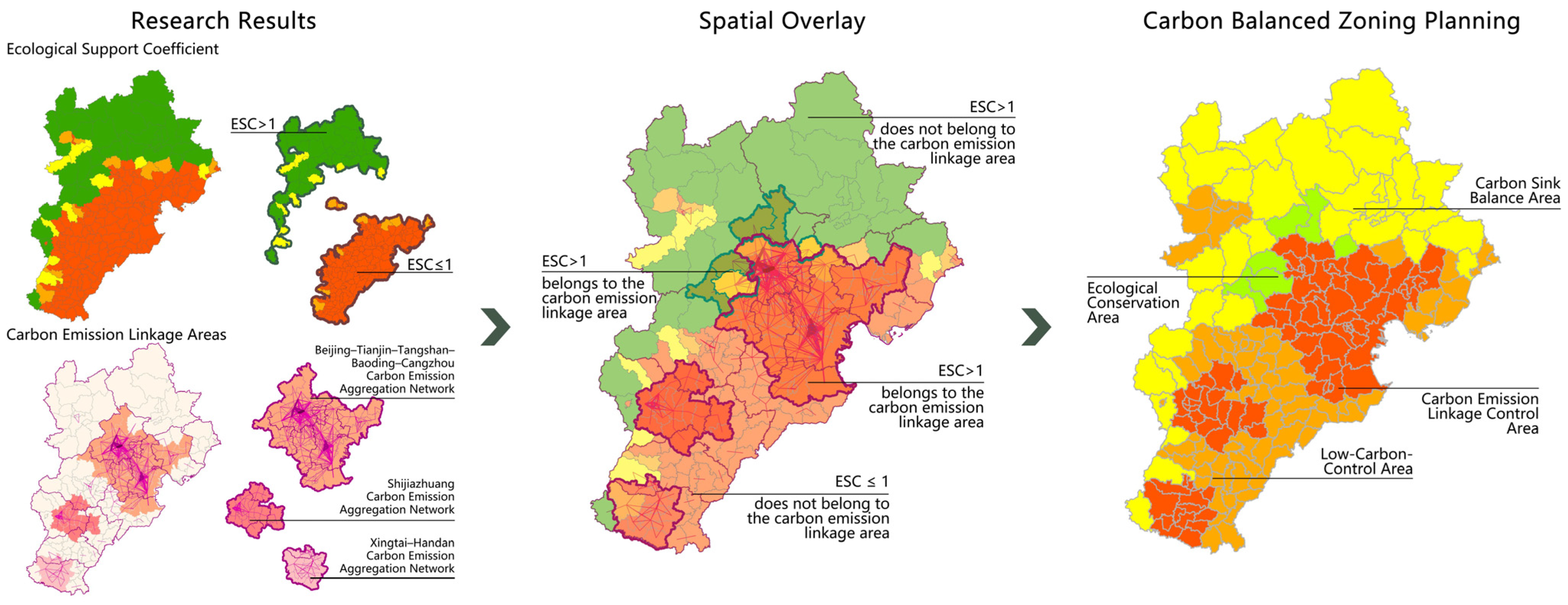
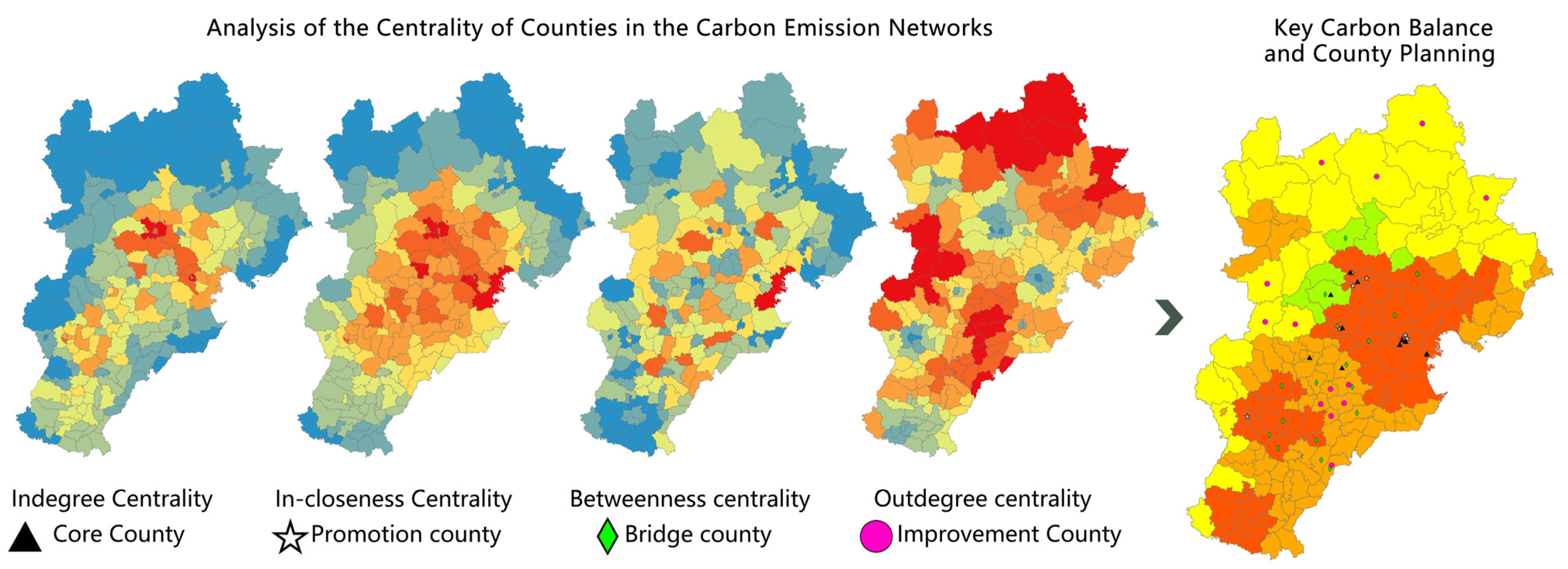
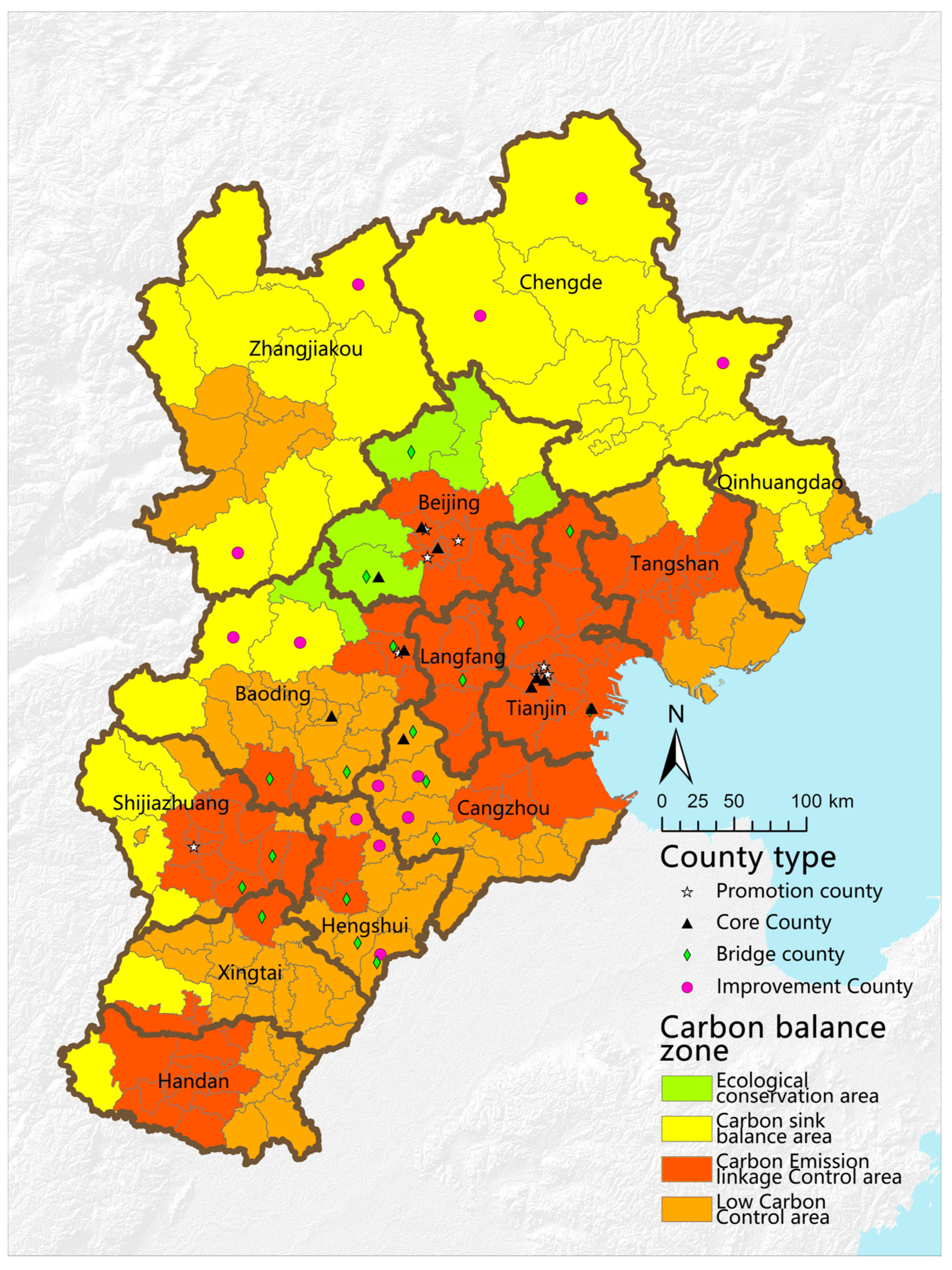
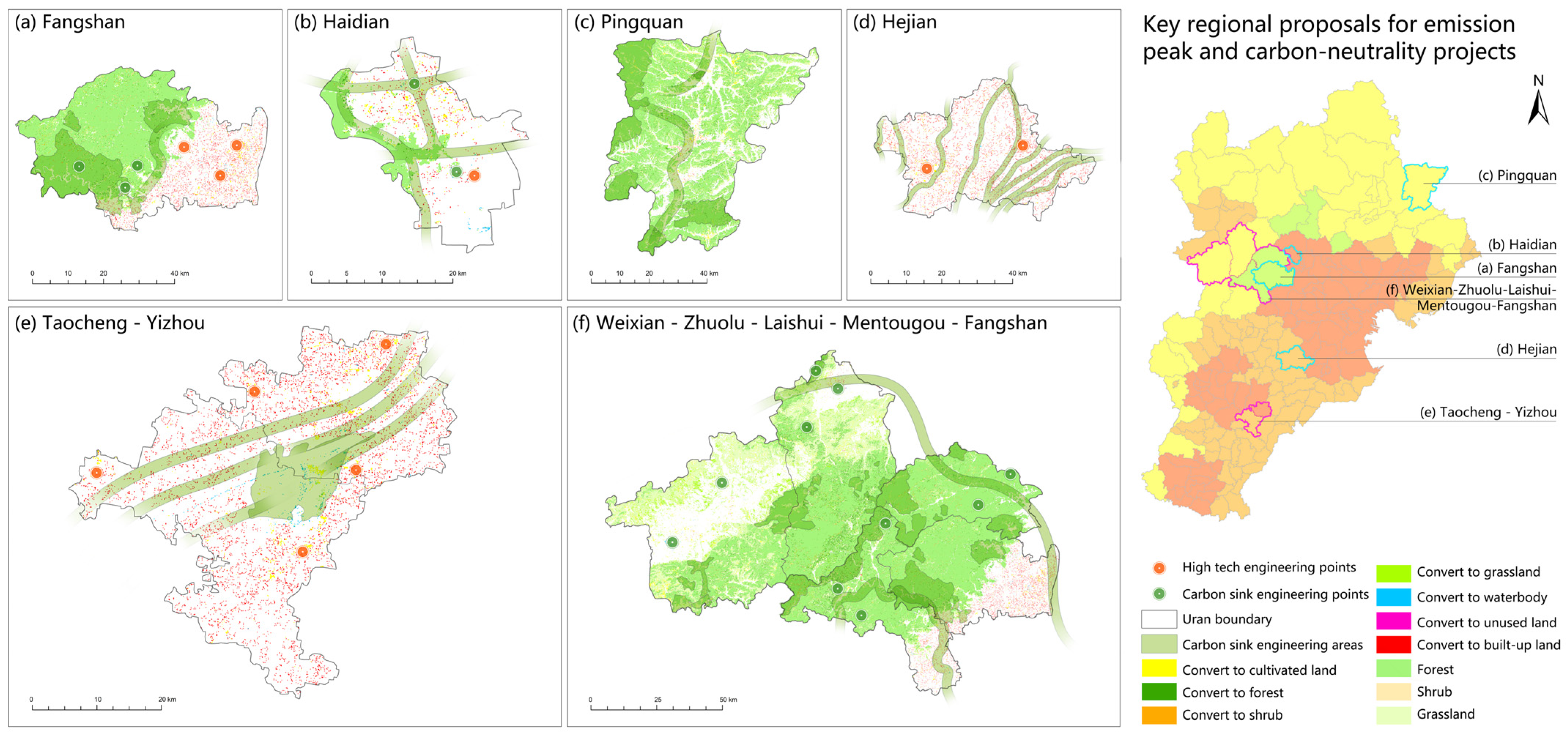
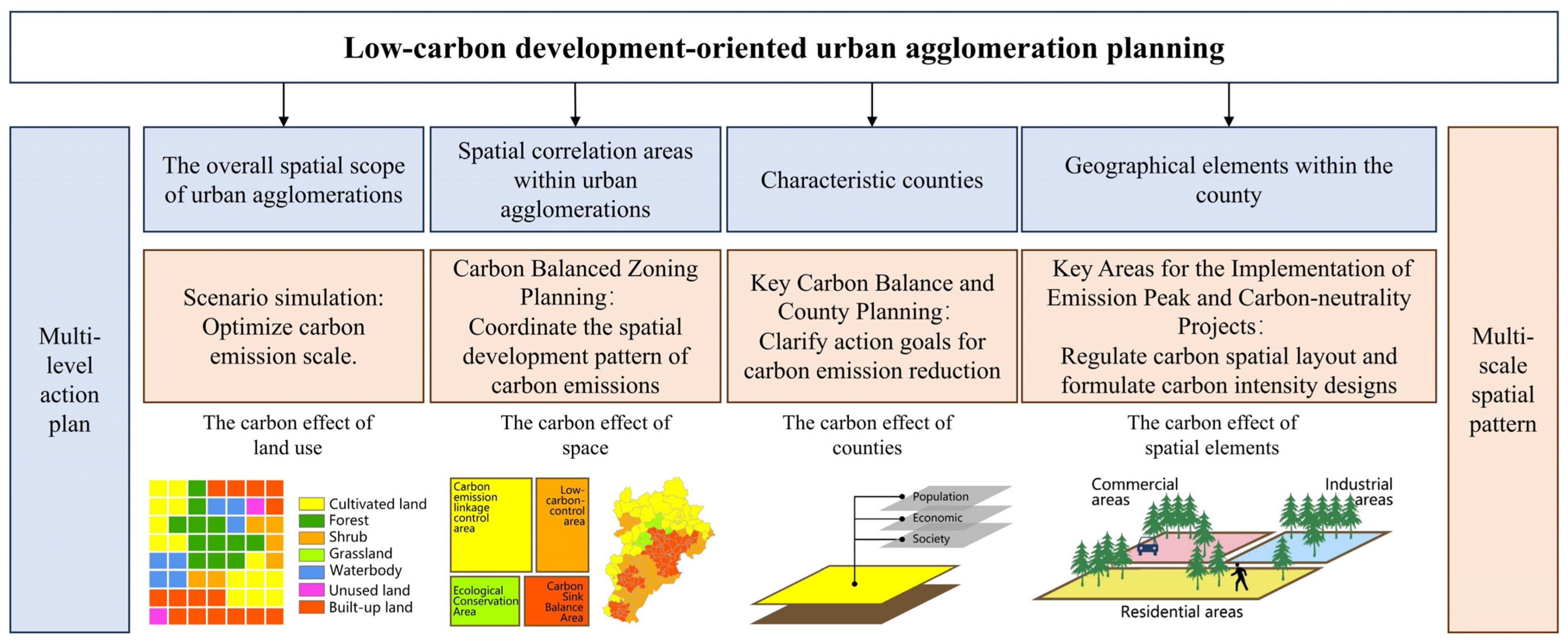
| Data Types | Data | Years | Spatial Resolution (m) | Sources |
|---|---|---|---|---|
| Land use datasets | Land use | 2000, 2010, 2020 | 30 | Jie Yang and Xin Huang (2022). The 30 m annual land-cover dataset and its dynamics in China from 1990 to 2021 [Dataset]. In Earth System Science Data (1.0.1, Vol. 13, Number 1, pp. 3907–3925). Zenodo. https://doi.org/10.5281/zenodo.5816591 [24] |
| Climate environmental datasets | Soil type | 2018 | 30 | Resource and Environmental Sciences Data Center, Chinese Academy of Sciences |
| Annual mean temperature | 2020 | 30 | National Tibetan Plateau Data Center | |
| Annual mean precipitation | 2020 | 30 | National Tibetan Plateau Data Center | |
| DEM | 2020 | 30 | Geospatial Data Cloud | |
| Slope | 2020 | 30 | Generated from DEM data using ArcGIS | |
| Socioeconomic datasets | GDP | 2019 | 1000 | Resource and Environmental Sciences Data Center, Chinese Academy of Sciences |
| POP | 2019 | 1000 | Resource and Environmental Sciences Data Center, Chinese Academy of Sciences | |
| Proximity to railway | 2020 | 30 | Open street map | |
| Proximity to motorway | 2020 | 30 | Open street map | |
| Proximity to national highway | 2020 | 30 | Open street map | |
| Proximity to river water | 2020 | 30 | Open street map | |
| Nighttime light data | 2020 | 1000 | Chinese Long Time Series Nighttime Light Dataset of China (2000–2020) https://doi.org/10.3974/geodb.2022.06.01.V1 [25] | |
| Future driver dataset | National nature reserves | / | / | China Nature Reserve Specimen Resource Sharing |
| Land Use Types | Coefficient (ton CO2/hm2) | References |
|---|---|---|
| Cultivated land | 0.42 | Fang et al., 2007 [29], She et al., 2017 [31] |
| Forest | −0.62 | Fang et al., 2007 [29], Cui et al., 2019 [28] |
| Grassland | −0.14 | Fang et al., 2007 [29], Cui et al., 2019 [28] |
| Shrub | −0.23 | Tang et al., 2018 [32], Cui et al., 2019 [28] |
| Waterbody | −0.03 | Fang et al., 2007 [29], Cui et al., 2019 [28] |
| Built-up land | 120.37 | Liu et al., 2023 [30], Yan et al., 2022 [33] |
| Unused land | −0.05 | Cui et al., 2019 [28] |
| Network Characteristics | Formula | Symbolic Meaning | Role | |
|---|---|---|---|---|
| Degree of Centrality | Outdegree Centrality | indicates whether there is a direct connection between counties, where 1 indicates a direct connection and 0 indicates no connection; is the number of cities in the network | Directly reflects the status of nodes in the network | |
| Indegree Centrality | ||||
| Closeness of Centrality | In-closeness Centrality | denotes the shortest spherical distance from county to county | Reflects the degree to which each city in the entire network is not dominated by the other cities | |
| Out-closeness Centrality | ||||
| Betweenness Centrality | represents the total number of shortest paths from county to county that generate links; is the number of shortest paths from county to county that generate links through county | Reflects the extent to which a node can control the relationships between other nodes | ||
| Cultivated Land | Forest | Shrub | Grassland | Waterbody | Unused Land | Built-Up Land | |
|---|---|---|---|---|---|---|---|
| Real (2020) | 472,275 | 265,462 | 3252 | 160,055 | 15,016 | 265 | 160,376 |
| Simulation results (2020) | 472,401 | 265,338 | 3226 | 159,874 | 14,225 | 282 | 161,355 |
| Year | Scenario Analysis | Cultivated Land | Forest | Shrub | Grassland | Waterbody | Unused Land | Built-Up Land |
|---|---|---|---|---|---|---|---|---|
| 2020 | 9,433,128 | 5,314,139 | 63,930 | 3,189,193 | 281,330 | 4652 | 3,224,288 | |
| 2035 | ND | 9,236,893 | 5,565,082 | 58,023 | 2,909,005 | 299,492 | 2086 | 3,440,079 |
| EP | 9,061,265 | 5,639,408 | 56,856 | 3,059,093 | 303,338 | 2905 | 3,387,795 | |
| 2020–2035 | ND | −196,235 | 250,943 | −5907 | −280,188 | 18,162 | −2566 | 215,791 |
| EP | −371,863 | 325,269 | −7074 | −130,100 | 22,008 | −1747 | 163,507 |
| Scenario Analysis | Cultivated Land | Forest | Shrub | Grassland | Waterbody | Unused Land | Built-Up Land |
|---|---|---|---|---|---|---|---|
| ND | 387.95 | −345.04 | −1.33 | −40.73 | −0.90 | −0.01 | 41,408.23 |
| EP | 380.57 | −349.64 | −1.31 | −42.83 | −0.91 | −0.01 | 40,778.89 |
| Degree of Centrality | Closeness of Centrality | Betweenness of Centrality | |||||||
|---|---|---|---|---|---|---|---|---|---|
| Outdegree Centrality | Indegree Centrality | Out-Closeness Centrality | In-Closeness Centrality | ||||||
| Cities | No. | Cities | No. | Cities | No. | Cities | No. | Cities | No. |
| Chengde | 6 | Beijing | 10 | Hengshui | 8 | Tianjin | 9 | Baoding | 4 |
| Baoding | 4 | Tianjin | 8 | Baoding | 6 | Beijing | 8 | Beijing | 4 |
| Cangzhou | 4 | Baoding | 1 | Cangzhou | 4 | Baoding | 2 | Cangzhou | 3 |
| Hengshui | 4 | Shijiazhuang | 1 | Shijiazhuang | 1 | Cangzhou | 1 | Hengshui | 3 |
| Zhangjiakou | 2 | Zhangjiakou | 1 | Tianjin | 3 | ||||
| Langfang | 1 | ||||||||
| Shijiazhuang | 1 | ||||||||
| Xingtai | 1 | ||||||||
| Carbon-Balance Zoning | Division Criteria | Functional Features | |
|---|---|---|---|
| Ecological conservation area | ESC > 1, belongs to the carbon emission linkage area | The ecological conservation area primarily resided in the northwestern region of the Beijing–Tianjin–Tangshan–Baoding–Cangzhou carbon emission linkage area. It accounted for 4.699% of the urban agglomeration area. The region has strong carbon sink capacity and is situated within the carbon emission linkage area, so it can give full play to the carbon sink regulation capacity of the ecological region and drive the overall coordinated emission reduction within the carbon emission network. | |
| Carbon sink balance area | ESC > 1, does not belong to the carbon emission linkage area | The carbon sink balance area was located mainly in the northwestern part of Hebei Province. It accounted for 43.322% of the urban agglomeration area and was composed mainly of 33 counties. The region has a strong ecological function, high carbon sink benefit, and low carbon emissions, so it is suitable to introduce economically developed county industries appropriately and continue to carry out ecological environmental construction. | |
| Carbon emission linkage control area | ESC ≤ 1, belongs to the carbon emission linkage area | The carbon emission linkage control area was composed mainly of counties in three carbon emission linkage areas. It accounted for 22.207% of the urban agglomeration area and was composed mainly of 87 counties. The region exhibits significant carbon emissions and is integrated into the carbon emission network, enabling it to effectively utilize the influence mechanism of the carbon emission network and establish a regional carbon emission reduction linkage system [20]. | |
| Low-carbon control area | ESC ≤ 1, does not belong to the carbon emission linkage area | The low-carbon control area was located mainly in the central and southern parts of the urban agglomeration. It accounted for 25.369% of the urban agglomeration area and was composed of 74 counties. The region has high carbon emissions, but it has less contact with other counties in the BTH region and is difficult for the other counties to affect. It is necessary to strengthen communication with other regions and gradually carry out project cooperation and technical exchanges with provinces and cities. | |
| County Type | Division Criteria | Functional Features |
|---|---|---|
| Core county | Counties with higher indegree centrality | These counties dominate the central position within the carbon emission network, deserving top priority in shaping regional policies for carbon emission reduction. The optimization of socioeconomic development and energy development top-level design in these core counties is essential. The construction of a carbon emission trading market should be strengthened with market-oriented low-carbon mechanisms. |
| Promotion county | Counties with higher in-closeness centrality | Counties that are more connected to other counties can change their car-bon emission behaviors and the carbon emission behaviors of their neighboring counties more quickly, so they should be used as promotion counties for carbon emission reduction and sink increase, further promoting emission peak and carbon neutrality policies according to local conditions. The government can learn from the experience of advanced cities to promote the effective implementation of coordinated emission reduction planning. |
| Bridge county | Counties with higher betweenness centrality | Counties that play a communication role in the network can control the coordinated emission reduction process in other cities in a planned manner. These counties provide network communication and can carry out key planning control. By limiting some functions, the government can minimize the exchange of ineffective carbon emissions, impede unnecessary carbon emission connections. |
| Improvement county | Counties with higher outdegree centrality | These counties exhibit a greater number of spatial spillover relationships within the carbon emission network and bear a higher burden of carbon emissions. Their ecological conservation function is strong, and their spillover effect can be used to carry out ecological environmental construction and avoid ecological degradation caused by overurbanization and industrial development. |
| Region Type | Prefecture -Level City | County | Carbon Balance Zoning | County Type | Key Areas for Emission Peak and Carbon Neutrality Projects |
|---|---|---|---|---|---|
| Single County | Beijing | Fangshan District | Ecological Conservation Area | Extension County, Bridge County | Carbon reduction: Yanfang, Liangxiang, Doudian, three high-tech clusters Sink enhancement: Juma River Basin, Shidu Scenic Spot, Shihua Cave Scenic Spot, Baicao Riverside Scenic Spot, Yongding River Forest Wetland Leisure Belt. |
| Beijing | Haidian District | Carbon Emission Linkage Control Area | Core County, Promotion County | Carbon reduction: Zhongguancun Science City Sink enhancement: Xishan Ecological Barrier, Green Heart of Three Hills and Five Gardens, Green Heart of Ecological Science and Technology. | |
| Chengde | Pingquan City | Carbon Sink Balance Area | Improvement County | Sink enhancement: ecological protection of Liaoheyuan Forest Ecological Reserve, Shihu Forest Park, Qinghe Forest Park, Yamenzi Forest Park, Shuangfengshan Forest Park, Shanwanzi Forest Park, Longtanshan Forest Park, Pu River Waterfront Ecological Corridor. | |
| Cangzhou | Hejian City | Low-Carbon Control Area | Improvement County, Bridge County | Carbon reduction: central urban area and eastern cluster Sink enhancement: Nine River System (referring to the nine main rivers in the city, including east branch of Xiaobai River, Yujia River, Guyang River, east branch of Ren River, west branch of Ren River, Ziya River, Beipai River, and west branch of Heilonggang River). | |
| Cross- Regional Cooperation | Hengshui | Taocheng District, Jizhou District | Carbon Emission Linkage Control Area, Low-Carbon Control Area | Bridge County | Carbon reduction: National Demonstration Zone for Transformation of Scientific and Technological Achievements to the south of Beijing, Hengshui High-Tech Industry Development Zone, Taocheng High-Tech Industry Development Zone, and Jizhou High-Tech Industry Development Zone Sink enhancement: Hengshui Lake National Nature Reserve, Fuyang River Water Ecological Comprehensive Renovation Area, Taocheng Urban Area–Binhu New Area and Jizhou Urban Area Blue and Green Space System, Fuyang New River–Fudong Pai River Flood Discharge Corridor, Fuyang River, and Yanhe Old Course. |
| Zhangjiakou– Baoding– Beijing | Yu county, Zhuolu County, Laishui County, Mentougou District, Fangshan District | Carbon Sink Balance Area, Ecological Conservation Area | Bridge County, Promotion County, Improvement County | Sink enhancement: Important water ecological corridor: Mentougou District–Fangshan District–Yu County–Zhuolu County: Yongding River Basin (Zhangjiakou Section) Laishui County–Fangshan District: Water Source Protection Area of Juma River Basin Important nature reserves: Yu County–Zhuolu County: Xiaowutai Mountain National Forest Ecological Reserve in Hebei Province Zhuolu County–Laishui County: Jinhua Mountain–Henglingzi Crossoptilon Mantchuricum Nature Reserve Mentougou District–Fangshan District: Beijing Baihuashan National Forest Ecological Reserve. |
Disclaimer/Publisher’s Note: The statements, opinions and data contained in all publications are solely those of the individual author(s) and contributor(s) and not of MDPI and/or the editor(s). MDPI and/or the editor(s) disclaim responsibility for any injury to people or property resulting from any ideas, methods, instructions or products referred to in the content. |
© 2024 by the authors. Licensee MDPI, Basel, Switzerland. This article is an open access article distributed under the terms and conditions of the Creative Commons Attribution (CC BY) license (https://creativecommons.org/licenses/by/4.0/).
Share and Cite
Li, H.; Liu, Y.; Li, Y.; Li, X.; Yan, S.; Zheng, X. How to Realize Synergistic Emission Reduction in Future Urban Agglomerations: Spatial Planning Approaches to Reducing Carbon Emissions from Land Use: A Case Study of the Beijing–Tianjin–Hebei Region. Land 2024, 13, 554. https://doi.org/10.3390/land13040554
Li H, Liu Y, Li Y, Li X, Yan S, Zheng X. How to Realize Synergistic Emission Reduction in Future Urban Agglomerations: Spatial Planning Approaches to Reducing Carbon Emissions from Land Use: A Case Study of the Beijing–Tianjin–Hebei Region. Land. 2024; 13(4):554. https://doi.org/10.3390/land13040554
Chicago/Turabian StyleLi, Haoran, Yang Liu, Yixiao Li, Xiaoxi Li, Shuyi Yan, and Xi Zheng. 2024. "How to Realize Synergistic Emission Reduction in Future Urban Agglomerations: Spatial Planning Approaches to Reducing Carbon Emissions from Land Use: A Case Study of the Beijing–Tianjin–Hebei Region" Land 13, no. 4: 554. https://doi.org/10.3390/land13040554






